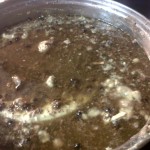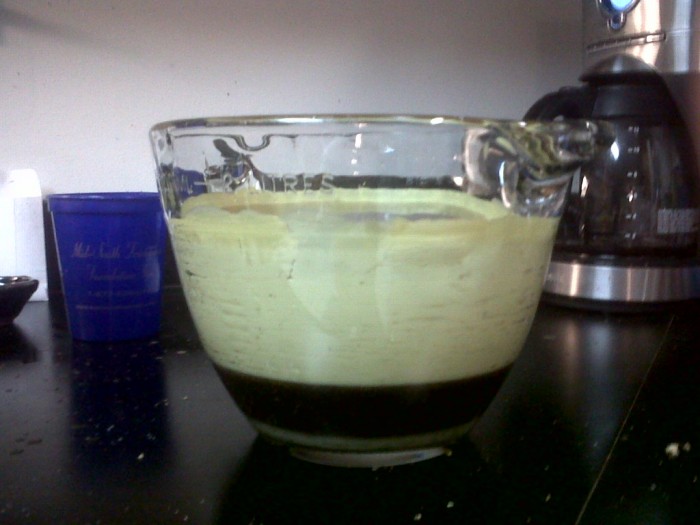[Today’s run: rest day]
Our beekeeping method involves taking frames out of the hive, cutting out the honey-filled comb, squeezing out the honey. We put the drained comb/wax in a container for later processing.
I’ve been slow in getting my waxed processed recently, so we have had some wax moths and ants get into it. That’s an ugly picture. But today I finally got out the old dutch-oven and hot plate and dumped in a bunch of the junk wax that we have lying around.
I melt the wax with a couple of inches of water in the pot. Water dilutes any remaining honey. Wax is waterproof and it melts at a temp less than boiling water. Honey is water soluble. The rest of the junk is dirt and trash which can be mechanically filtered. So, hot water and cheesecloth are the tools.
 When the water starts to get warm, bubbles of clean wax will come up to the surface. I stir around the wax and junk (sticks, bee husks, dead bees, wax worms, etc. etc). Eventually it starts to melt. It all forms a sludge.
When the water starts to get warm, bubbles of clean wax will come up to the surface. I stir around the wax and junk (sticks, bee husks, dead bees, wax worms, etc. etc). Eventually it starts to melt. It all forms a sludge.
The wax turns into a paste. Then gradually it clears up and you have “layers”. The water and honey will go to the bottom. The wax will go to the top. Junk will float in the wax at various layers.
I used some cheesecloth (honey work seems to require lots of cheesecloth!) to filter out the big chunks as I poured off the top of the pot into a large glass measuring cup. I could have gone further but my sludge had a lot of junk in it and less wax as you get toward the bottom. I decided to toss the rest out.
I then cleaned up the pot by boiling some water in it and getting the wax and sludge remains to melt again. I wiped it out with paper towels.
Here is my product. When it is completely cool I will put the measuring cup in some very hot water to loosen the wax. I’ll dump out the honey-water.
There is still quite a bit of junk in this wax. I’ll add it with some other and try to refine it at least once more.
